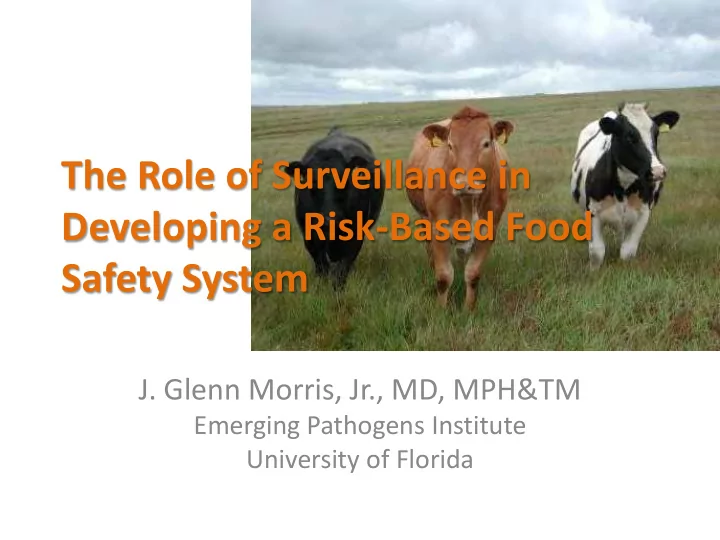

The Role of Surveillance in Developing a Risk-Based Food Safety System J. Glenn Morris, Jr., MD, MPH&TM Emerging Pathogens Institute University of Florida
Approaches to Control of Foodborne Illness • Risk-based
Approaches to Control of Foodborne Illness • Risk-based o “A systematic means by which to facilitate decision making to reduce public health risk” • Data intensive Strategic data collection o Improved access to data o Modern Information o Technology (including EMR) Increased analytic capacity o
Roles of Food Safety Agencies • Short term responsibilities: generally reactive – Outbreak recognition – Identification of source/trace-back – Regulatory action/recall However, outbreaks constitute only a small fraction of total foodborne disease burden… • Longer term responsibilities: generally proactive A well designed proactive approach will enhance many of the elements essential to an optimal short- term/reactive response
Risk-Based Food Safety System 1. Strategic planning 2. Public health 6. Monitoring risk ranking and review 3. Targeted 5. Design of information intervention plan gathering 4. Analysis and selection of interventions NAS. Enhancing Food Safety . 2010 (p. 82)
Step 1: Strategic Planning • Identify public health objectives related to food safety • Establish a risk management plan (general and specific strategic plans for meeting public health objectives and for considering and choosing policy interventions to achieve these objectives) • Establish metrics with which to measure performance in consultation with stakeholders
Integrated Measures of Disease Burden
Step 2: Public Health Risk Ranking • Develop or select tools (models, measures, or other) for public health risk ranking in consultation with stakeholders • Rank risks based on public health outcomes • Report results to stakeholders and solicit feedback
Report released: April 28, 2011 Funded by: Robert Wood Johnson Foundation Available: epi.ufl.edu
Major Steps in Analysis 14 pathogens in 12 food categories Incidence Estimates {annual illnesses, hosp’s, death due to each pathogen} Rank Pathogens {$& QALYs} Public Health Impact {$ and QALY loss due to Rank Pathogen- each pathogen} Food Combinations {$ & QALYs} Food Attribution {$ and QALY loss due to each pathogen-food combination} Rank Foods (sum across pathogens) {$ & QALYs}
Primary Food Safety Problems in the U.S.
Step 3: Targeted Information Gathering on Risks and Consideration of Other Factors that may Influence Decision Making Step 4: Analysis and Selection of Interventions Step 5: Design of an Intervention Plan 1. Strategic planning 2. Public health risk 6. Monitoring and ranking review 3. Targeted 5. Design of information intervention plan gathering 4. Analysis and selection of interventions
Step 6: Monitoring and Review • Collect and analyze data on evaluation measures selected during strategic planning • Interpret data and evaluate whether the interventions result in the desired intermediate outcomes • Determine whether public health objectives are being met by using performance metrics developed in Step 1 (broad strategic planning) • Communicate the results to stakeholders • Review and refine the entire process in an iterative manner as necessary to accomplish both intermediate outcomes and public health objectives so as to achieve continuous improvement over time
Risk-Based Food Safety System 1. Strategic planning 2. Public health 6. Monitoring risk ranking and review 3. Targeted 5. Design of information intervention plan gathering 4. Analysis and selection of interventions NAS. Enhancing Food Safety . 2010 (p. 82)
Surveillance Data • Human disease surveillance • Food/product surveillance • Animal surveillance • Environmental surveillance 1. Strategic planning • Molecular surveillance 2. Public health risk 6. Monitoring and ranking review 3. Targeted 5. Design of information intervention plan gathering 4. Analysis and selection of interventions
Surveillance: Gaps and Challenges • Legacy systems (and legacy thinking) • Fragmented data collection • Lack of data sharing among government entities • Lack of industry data • Poor IT capacity – Need for data standards – Modernization of IT capacity – Failure to make use of ESSENCE/EMR • Poor capacity for development of analytic systems We have lots of data. What we don’t have is good analytic and IT capacity – and we’re often missing the specific data necessary to answer our questions (i.e., because of the way things were put together, there are critical data gaps)
Surveillance as Part of a Risk-Based Approach to Food Safety • Figure out what you want/need before you start • See surveillance not as an end in itself, but as a carefully designed component of an overall analytic system to identify, prioritize, and mitigate risk of foodborne illness • Dump what you don’t need (and save money doing it) • Keep and refine what is providing useful information • Add (creatively) what is essential to do the analyses to build a risk-based system
Recommend
More recommend